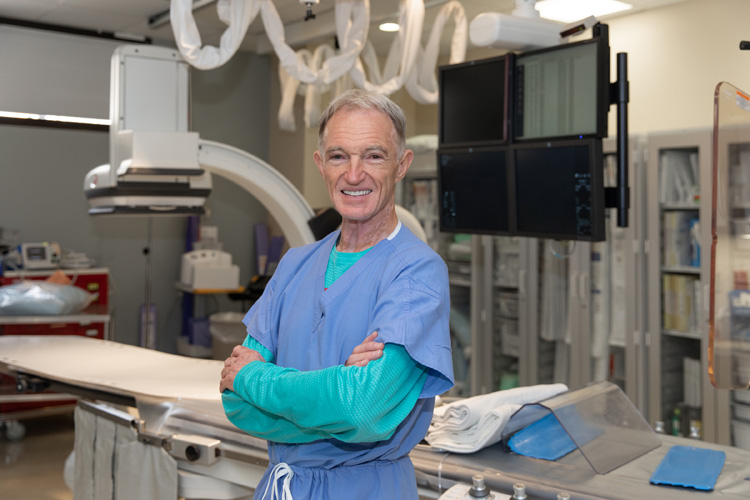
Leave it to Sebastian interventional cardiologist Dr. Charles Croft to once again pioneer the use of a modern modification of an older technology and achieve impressive results.
First it was the lowly stent, those tiny bare metal mesh tubes used to keep coronary arteries open after a balloon angioplasty procedure.
According to Harvard Medical, “an estimated 2 million people get coronary artery stents every year” in an effort to keep their arteries open so they can provide blood and oxygen to the heart and prevent heart attacks.
The basic stent had been widely used since the mid-1980s.
Croft, however, was one of the first in this area to embrace a new incarnation of these tiny lifesavers, the “drug-eluting” stent. These newer stents feature a polymer coating that elutes – or slowly releases – medications that help keep those arteries open longer.
Now Croft has adopted a modernized version of the Rotablator, a tool long used for the mechanical clearing of plaque and calcium buildup inside coronary arteries – a procedure known as “rotational ablation.”
The Arrhythmia and Electrophysiology Review says this type of procedure was first used more than two decades ago to remove rock-hard or “calcified” buildups of plaque lodged inside the arteries – but it had some drawbacks.
As Croft explains, “the old version – the Rotablator – was a concentric string device and it spun pretty rapidly, about 160,000 to 200,000 revolutions per minute.”
That made cutting through calcified plaque fairly easy, but it also made the spinning grinder difficult to control. So difficult, in fact, that it would sometimes rupture the very artery the physician was trying to clear.
The new generation procedure – with new rotating tools – says Croft, is a notable improvement.
Croft has opted to use a device made by Cardiovascular Systems, Inc. called the Diamondback 360 Coronary Orbital Atherectomy System.
“It’s a little more friendly than the Rotablator,” Croft says.
The older devices “spun so fast that they wanted to go centrifugally. They wanted to go straight, and when it spins that fast it just doesn’t want to take a bend, so you can perforate an artery with a Rotablator.”
The device Croft uses now “spins more slowly and works in a different way. You can adjust how much of the artery you want to ablate.”
It also spins differently.
“It spins like a skipping rope,” says Croft, “so the deepest part of that curve is the middle part of the skipping rope and it moves eccentrically so that it doesn’t stay in a straight path all the way down.”
That’s important because blood vessels don’t run in straight paths, either.
Another problem with the previous generation of these devices, Croft adds, was that they “would go forward, but you might not be able to get them back. They would sometimes get stuck going through a hard calcium deposit.”
The device Croft uses now is diamond-coated on both sides, “so as it spins, it abrades the artery both in the [forward] direction and [backward] direction.”
The New England Journal of Medicine says Croft’s approach to rotational ablation has “successfully reduced stenosis (the abnormal narrowing of the artery) in 94 percent of procedures and was effective even in complex and calcified lesions.”
This genial South African, with more than 40 years of interventional cardiology experience, freely admits “it’s a complicated device [but it is] … definitely an improvement.”
That improvement is important here in Vero Beach.
As Croft points out, “the demographics of this area mean that we have [people with] complicated blood vessels and this gives us a tool to handle that subset of patients that we otherwise could not handle.”
Pausing briefly, he adds, “the [only] other alternative is bypass surgery.”
That’s key. “Under normal circumstances,” says Croft, “I’d say it takes maybe five minutes or even less to set up. And [the rotational ablation procedure itself] is usually about 15 minutes.”
More importantly, Croft adds, “the vast majority of people go home the next day.” Recovery and return time from bypass surgery is substantially longer and the risk of complications is exponentially higher.
Croft says he has done “probably around 80” of these newer procedures. “I think our success rate has got to be better than 90 percent.”
Dr. Charles Croft is with both Sebastian River Medical Center’s cath lab and the Holmes Regional Medical Center in Melbourne. His phone number in Sebastian is 772-388-4305. In Melbourne it’s 321-772-3288.



